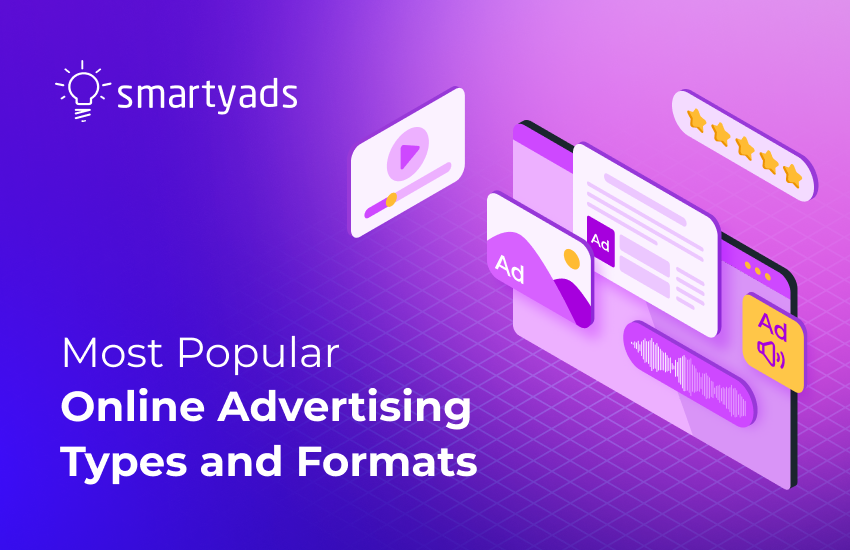Here is an update of the article on how to build a demand-side platform by SmartyAds expert Oleg Tymchyshyn published back in 2018. Since then, all our expectations have come true, and the market has grown incredibly fast. The popularity of AdTech platforms and programmatic advertising increased in all world regions, the technology became more accessible, competition in the niche intensified, and now AdTech players earn more.
Today, when looking at how to start a DSP company, enterprises may choose from many ready-made solutions. The AdTech market has lots of small players, and it’s expected to grow in the coming years again. Even undergoing global challenges.
To build your own DSP is an unpopular option for 2024. Because six years ago it cost up to $1.5-2.5 million per year. Currently, turnkey DSP development has significantly grown in price, because technologies have become more complex. Also, building a DSP turned out to be much more difficult for companies that decided to enter the AdTech market, developing their technologies from scratch. Check the top trends section and imagine how difficult it is to enter such a competitive business environment nowadays.
But the good news is that you don't need to build a demand-side platform yourself: there are ready-made DSP and data management solutions on the market that allow you to quickly enter a niche and start within weeks. Instead of years writing code, you will need 2–3 weeks to adapt. Agree, this is progress.
So, here is a demand-side platform tutorial for a quick understanding of the technical background behind creating your own DSP software. Before building DSP, take care of project evaluation.
How Common is Full-Stack In-House Among Companies?
According to IAB stats, only 18% of advertisers may boast of having a full ad tech stack for programmatic real-time bidding. That's not surprising since the development of your own DSP might take too much time and effort. You need to hire ad tech engineers, undergo a long development cycle, provide a budget for maintenance, and literally “reinvent the wheel” creating ad-server and bidder features for your DSP.
Along with these complexities, advertisers may significantly improve ad performance and eliminate commissions, having their own DSP under control.
By building a custom DSP agencies may expand their offerings and add real-time bidding to their service lists. Even though the programmatic market is already saturated, the demand for good ad tech providers is still rising.
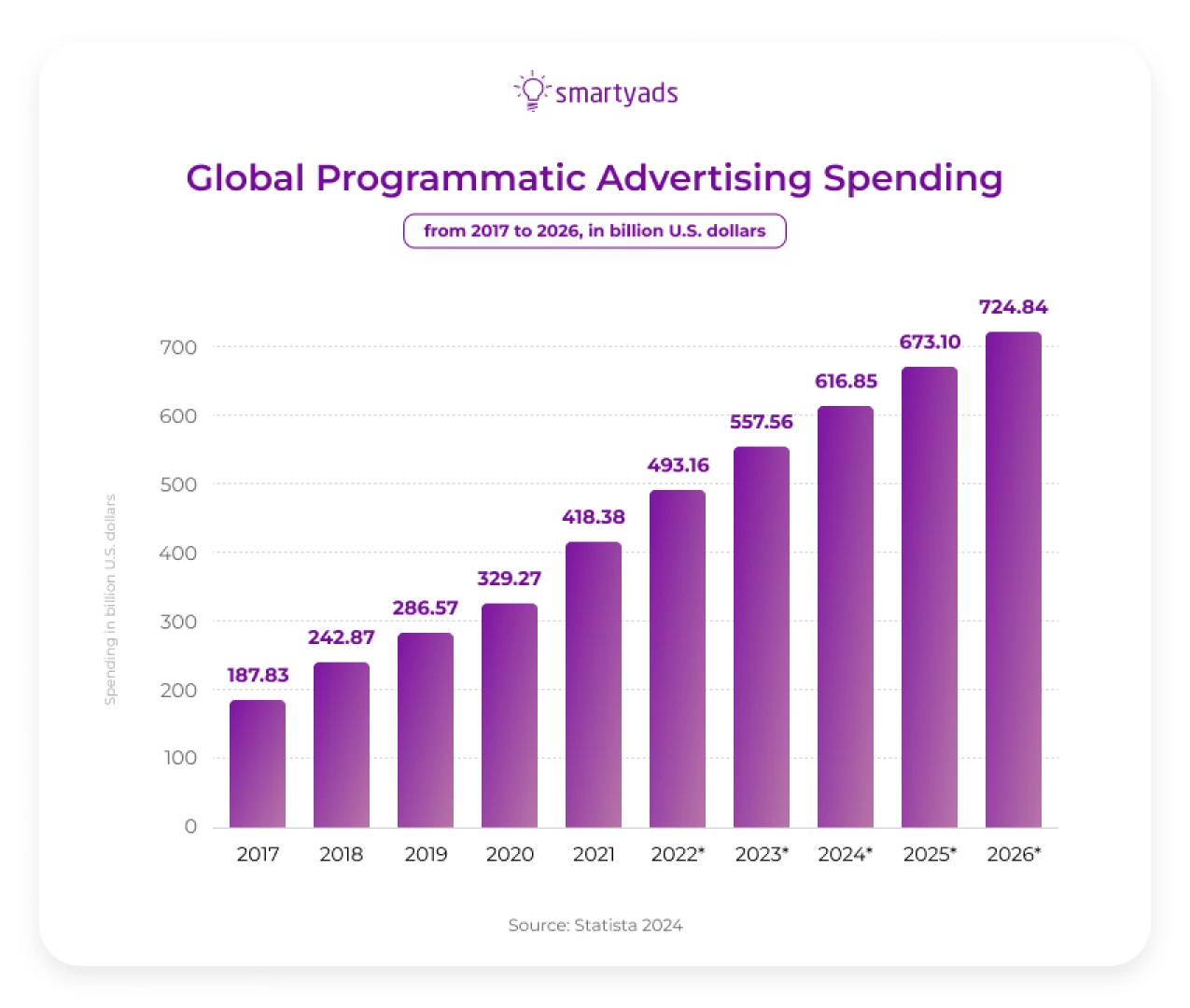
Source: Global programmatic advertising spending from 2017 to 2026 (in billion U.S. dollars)
In 2023 global programmatic advertising spending has grown to more than $557 billion from $493 billion established in 2022. At the same time, the programmatic’s share is expected to increase even more in the coming years.
Ready to learn how to set up your own DSP? Then you have two options: build it from scratch or choose the white label DSP and customize it according to your needs. To decide which one suits you better, it is important to know the pros and cons of every model but first let’s examine how DSP actually works.
How Does a Demand-Side Platform Work?
A Demand-Side Platform is a cornerstone of programmatic ad buying. It is a piece of ad tech software that purchases inventory from publishers on behalf of advertisers via real-time bidding protocol and ensures delivery of ads of various formats on websites by ad servers. DSPs automatically connect advertisers to Ad Networks, Ad Exchanges, and Supply-Side Platforms and match the best bid with the certain inventory without human participation.
Learn more about the main features of a DSP.
How exactly does a DSP work? The process of ad buying via DSP includes 5 steps:
- An advertiser starts the ad campaign in a DSP specifying various data attributes of their target audience and adjusting budget settings.
- A DSP sends a request to ad exchanges and networks to access available inventory.
- A DSP analyzes what inventory matches specified parameters and selects suitable slots.
- A DSP evaluates the cost of the inventory and automatically bids on the impression based on predefined budget data.
- If the bid wins in the auction, a DSP sends a request to the ad server to deliver the ad to the end-user.
The process of ad serving may seem long, but it actually takes no more than 100 milliseconds while the webpage is loading.
What Do You Need to Set Up Your Own DSP
If you decided to build a DSP from scratch, you need to develop a number of algorithms responsible for bidding, data processing, and ad serving to implement the mechanism mentioned above.
RTB Bidder
The first component of a DSP is an RTB bidder. It evaluates inventory and determines the right value for each impression. Major bidder’s features you need to develop:
- A strong CPM bidding algorithm to choose the best request to bid on;
- A single-point management system to handle connections between ad campaigns, advertisers, ad exchanges, etc.
- Targeting/re-targeting algorithms for precise ad serving to the buyer’s target audience;
In addition to algorithms, to build an RTB bidder for your own DSP, you might need a machine learning engineer and data specialist.
Ad server
An ad server decides which ads to serve on the website, displays them to the user, and reports conversion data. Features to work on:
- PC and mobile ad serving algorithm;
- CPM maximizer algorithm to determine the best value per impression;
- Conversion tracking mechanism to provide constant feedback to advertisers, so they could run more cost-effective campaigns;
- Workflow management options;
- Selection, ranking, and filtering algorithms;
- Brand safety solutions to detect fraudulent ad inventory and prevent its purchase;
- Ad serving and traffic reporting, 3rd party data collection features, etc.
To put ad server features into practice, you need a data-crunching specialist and/or big data engineer.
Internal data platform
Also, it’s desirable to establish an internal data platform to retrieve additional user information from external DMPs and make targeting options more precise. The data platform is also needed for the data feed to the ad server and bidder. The development of such a platform requires a big data engineer.
Additional modules
If you want to win more clients, you might equip your DSP with additional modules, such as profit maximization, supply forecasting, CTR prediction, and other algorithms. After compiling all these components together, you’ll get a fully functioning custom DSP.
Pros and Cons of Building a DSP from Scratch
There’s definitely a lot of work to do if you want to set up your own DSP from scratch. Is the game worth the candles? Let’s review the pros and cons of full-stack DSP development.
PROS of Building Your Own DSP | CONS of Building Your Own DSP |
|
|
How much does exactly a full setup of a DSP cost? Technology investments may comprise up to $1.5 - $2.5 million per year. This sum includes engineering team salaries, infrastructure, maintenance expenses, and development costs. For example, disk storage of data for post-processing drains around $3,500 per month, that’s $42,000 per year.
If you run a small agency or a startup brand, the development expenses may exceed your earnings from advertising. It makes sense to set up a DSP from the ground up only if your advertising budget is more than $50M per year. Only in this case, do you save money in the long run.
Otherwise, you can consider an alternative solution — a white-label programmatic DSP. It holds all the benefits of a custom platform and almost none of the disadvantages as expenses on development are removed, the maintenance is guaranteed, and the necessary chain connections are already made.
A White Label Programmatic DSP as an Alternative Solution
There is a common myth that you can become #1 in your niche only if you develop a unique technology from scratch. That’s not exactly true.
For example, YouTube initially bought the video technology from Adobe and applied only cosmetic changes to its core. All videos on YouTube were played through a 3rd-party Adobe software until the service was purchased by Google in 2006. Nevertheless, that didn’t prevent YouTube from becoming the most popular video-sharing website in the world.
Similarly, you don’t need to develop a DSP on your own if you want to become #1 in online advertising, just acquire a ready-made solution and build your service model on it.
Top Trends You Should Follow in Your Own DSP
Next, we will look at the current trends in building in-house programmatic technologies that will dominate on the 2024 development market. So you will be able to analyze how to set up a DSP from scratch before starting.
AI-driven decision-making
As the number of bid requests processed by DSPs has increased, smart filtering systems have become the solution. They process the incoming stream of requests based on a variety of factors with real-time data updates and powered by AI technologies.
Programmatic advertising evolution
Today, linear optimization algorithms have become a thing of the past. Modern DSPs use machine learning technologies to optimize users' profits. Take a look at top DSPs that define programmatic buying in 2024.
Data privacy and compliance
Before developing a plan on how to make DSP, be sure to research the latest industry standards for data security compliance: GDPR, TCF 2.0, CCPA, COPPA, Sellers.json, Ads.txt. We also recommend studying the six main technologies safeguarding user privacy.
Blockchain for transparency
Blockchain serves as an element of payment security and a contract enforcement feature that keeps transactions safe from fraud. For instance, It is a core of the so-called Smart Contracts feature: when the terms of cooperation are written directly into the program code, which ensures that all involved parties comply with the terms.
Also, blockchain technologies can be used directly in the advertising chain: to make sure that none of the parameters added to the chain could be misplaced or lost.
Cross-channel integration
If you have watched the DSP coding tutorial, you will notice how much effort is required for seamless integration between different channels. Today, there are no template solutions for solving such issues, each case is unique and requires a certain amount of software development time.
Other features to improve user experience
It is not only about custom DSP solutions but also the implementation of commonly used functions. Monetizing data ethically, specific adaptation to privacy regulations, personalization using psychographics, and many more to develop for meeting competitive requirements.
What is a White Label DSP?
A white-label DSP is a ready-to-use demand-side platform that doesn’t bear any brand name and is ready for reselling. The buyer shapes up the product according to their own needs and offers it to clients as their programmatic advertising solution.
The majority of white-label DSPs are highly customizable. You can build a custom UI and interfaces, adjust DNS settings, and fine-tune the algorithms of your newly branded platform.
As we mentioned above, white-label DSP shares the benefits of a platform built from the ground up. Sure thing, it’s not free but it’s easy to calculate that the platform will quickly pay off compared to the budget needed for development.
What’s even more important, such a model allows capitalizing on the platform straight from the moment of buying. By purchasing a white-label DSP, you get instant access to thousands of publishers, hundreds of exchanges, and dozens of relevant extensions, increasing the value of each impression.
Case Studies: Innovators in DSP
We will not dive deep into all the case studies available on the website. Instead, let us tell you about the results of one of the latest our clients that is worth your attention.
Exciting Outcomes Using SmartyAds DSP: A Case Study
- Witness a staggering growth of 300,000 new users;
- Experience a remarkable reduction in Cost Per Installation (CPI) – down by nearly 11 times;
- Observe an impressive increase in conversion rates by 2%, coupled with a 4% rise in Click-Through Rate (CTR).
Explore our comprehensive case study to see the remarkable transformation achieved through the SmartyAds White Label DSP. If you're intrigued by these results and want to learn how this strategy can be replicated for your business, don't hesitate to contact us. We're here to provide further details and discuss how our solutions can lead to similar successes for you. Schedule a consultation with us today for an in-depth understanding.
Utilize the Best White Label DSP from SmartyAds
Let’s split the chores: you build a business, we build technology. SmartyAds White Label DSP gives you a competitive edge in digital advertising by:
- Supporting all ad formats available on the web (display, native, mobile, video, etc);
- Implementing precise targeting based on 1st and 3rd-party user data with full compliance to GDPR;
- Matching ads with the best inventory for the lowest possible price;
- Supporting best-performing techniques such as desktop and in-app header bidding;
- Providing real-time analytics and reporting.
Our white label platform is a ready-made solution, so after purchasing you can brand it and customize UI according to your needs and tastes. No ad tech knowledge is needed to set up your own DSP using SmartyAds technology. This means you will launch your first campaign or resell a ready-made solution to your clients in a matter of days.
Don’t spend years on building a DSP from scratch — buy a SmartyAds white-label DSP and create your own programmatic universe!
FAQ block
The most obvious benefit of building your own DSP is the long-term cost-saving. However, the biggest advantage is to own the technology code. With large advertising budgets, this is essential. All because you can deploy innovations as quickly as possible and have the flexibility to improve existing features depending on your unique business needs.
Concerning building a DSP from scratch — no, definitely not. Even enthusiasts with a strong technical background in AdTech need significant budgets for years of platform development. However, managing a ready-made platform is much easier. One of the possible ways for companies with limited resources is to buy back the code of the ready-made platform for further development and management.
To build a DSP from scratch means reinventing the wheel once again. You need a team of engineers to create a stable technology and many efforts to bring it to a competitive level. Instead, using a white-label DSP means spending a few weeks on adaptation, then connecting partners and starting to earn money paying royalties to the platform provider.
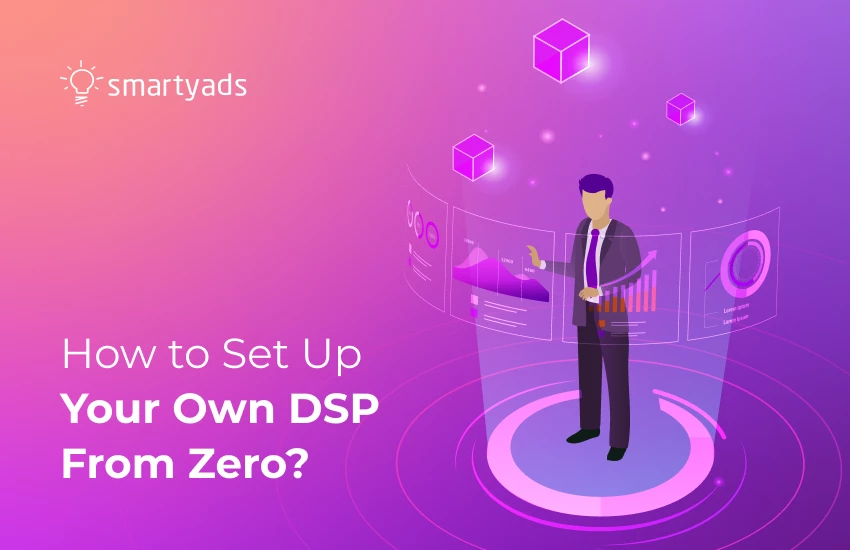
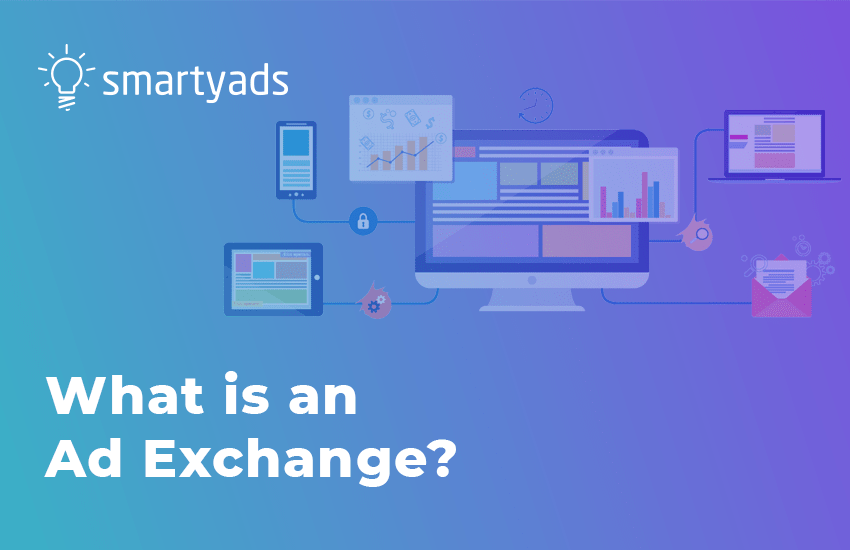
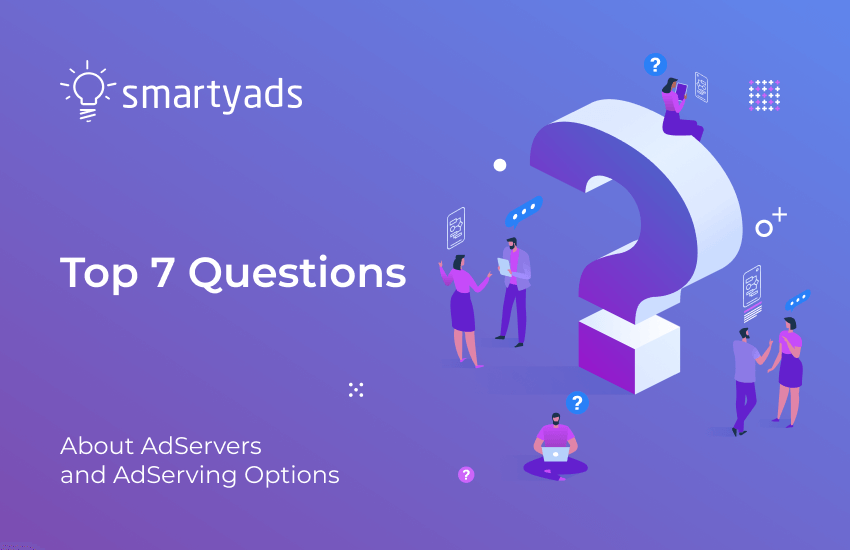
![In-App Advertising: the Complete Guide [Updated 2024]](/storage/uploads/2020/september/in-app-advertising-trends.png)
